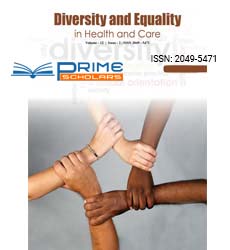Commentary - (2024) Volume 21, Issue 5
The Role of Culture and Society in Shaping Sexual Orientation
Zhang Wei*
Department of Biological Science, Tsinghua University, China
*Correspondence:
Zhang Wei,
Department of Biological Science, Tsinghua University,
China,
Email:
Received: 01-Oct-2024, Manuscript No. IPDEHC-24-21963;
Editor assigned: 03-Oct-2024, Pre QC No. IPDEHC-24-21963 (PQ);
Reviewed: 17-Oct-2024, QC No. IPDEHC-24-21963;
Revised: 22-Oct-2024, Manuscript No. IPDEHC-24-21963 (R);
Published:
29-Oct-2024, DOI: 10.35248/2049-5471-21.5.43
Description
Sexual orientation refers to the pattern of emotional, romantic,
or sexual attraction that an individual experiences toward
others. It encompasses a range of identities that reflect
different ways people experience attraction, and it is distinct
from gender identity, which pertains to an individual’s sense
of their gender. Sexual orientation is not a choice or something
that can be changed; it is a natural and intrinsic part of who a
person is. More recently, terms like pansexuality, which refers
to attraction to individuals regardless of gender, and asexuality,
where individuals experience little or no sexual attraction, have
gained visibility. Each of these orientations represents different
experiences of attraction, and they all highlight the spectrum of
human sexuality. One of the key aspects of sexual orientation is
that it is not confined to just sexual attraction; it also includes
romantic and emotional connections. For example, someone
who identifies as gay or lesbian may experience not only sexual
attraction to people of the same sex but also emotional and
romantic attraction. Similarly, bisexual individuals experience
these attractions toward more than one gender. It is important
to note that sexual orientation can evolve over time. Some
individuals may discover or come to terms with their orientation
at a later stage in life. For instance, someone might identify as
straight in their youth but realize in adulthood that they are
attracted to people of the same sex or both sexes. Conversely,
others may feel sure of their sexual orientation from a young
age. The fluidity of sexual orientation further underscores
the complexity and individuality of human sexuality. In many
parts of the world, understanding and acceptance of diverse
sexual orientations has increased, but challenges remain.
People who identify outside of the heterosexual norm often
face discrimination, prejudice, and marginalization. The stigma
surrounding non-heterosexual orientations can lead to social
isolation, mental health struggles, and barriers to acceptance
in various aspects of life, such as family, work, and healthcare.
As awareness and acceptance grow, society continues to shift
toward more inclusive attitudes and policies that protect
individuals’ rights to express their sexual orientation without
fear of discrimination or violence. In recent decades, there has
been a significant push for the legal recognition of rights for
individuals with diverse sexual orientations, such as the right to
marry, adopt children, and serve in the military. These advances
reflect growing societal recognition of the importance of
sexual orientation in defining individual identity and personal
freedom. Education and open dialogue about sexual orientation
are essential in reducing stigma and fostering a more inclusive
society. By promoting understanding and empathy, individuals
can help dismantle harmful stereotypes and support others in
their journey of self-discovery. Respecting each person’s right
to express their sexual orientation without fear of judgment is
a fundamental aspect of human dignity. In conclusion, sexual
orientation is a deeply personal and intrinsic part of who we
are, encompassing emotional, romantic, and sexual attraction.
It reflects the diversity of human experience and highlights
the importance of acceptance, understanding, and respect for
individual identity. As society continues to evolve, it is essential
to foster an environment where all people, regardless of their
sexual orientation, can live freely and authentically, without
fear of discrimination or harm.
Acknowledgement
None.
Conflict Of Interest
The author’s declared that they have no conflict of interest.
Citation: Wei Z (2024) The Role of Culture and Society in Shaping Sexual Orientation. Divers Equal Health Care. 21:43.
Copyright: © 2024 Wei Z. This is an open-access article distributed under the terms of the Creative Commons Attribution License, which permits unrestricted use, distribution, and reproduction in any medium, provided the original author and source are credited.

